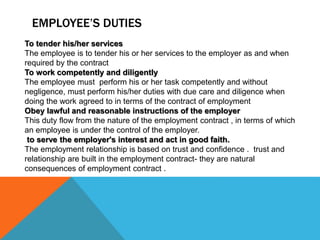Duties of the employer
- 1. To accept the employee into his service. Results in material breach if employer fails to take employee into his service as rendering of services is a prerequisite for payment. To provide the employee with work. Work must be provided if the employeeâs income is based on the amount of work he does i.e. commission based if an employer fails to provide employee with work it will result in a breach of employment contract .but generally if remuneration of employee is not based on work performed then there wonât be breach of employment contract if an employee is left idle Pay the agreed remuneration. The payment of wages/salaries is the primary duty of the employer in terms of an employment contract . The wage is determined in the contract by the parties themselves. DUTIES OF THE EMPLOYER
- 2. Provide safe working conditions. Employer must take reasonable steps to ensure the safety of its employees. Should failure to do so lead to the injury of the employee, the employer will be held liable , this common law duties is also supported by the occupational health and safety act 85 of 1993 section 8. Comply with statutory legislature/Acts . Obligations in terms of legislation. â BCEA LRA EEA e.t.c A duty of fair dealing with employees. this common law duties with the fairness of the employers procedures and polices . Employer must have policies and that are fair to all employees and in line with the legislation. Case law muarry vs minister of defence (2008) 6 B LLR 513 (SCA) constructive dismissal
- 3. EMPLOYEEâS DUTIES To tender his/her services The employee is to tender his or her services to the employer as and when required by the contract To work competently and diligently The employee must perform his or her task competently and without negligence, must perform his/her duties with due care and diligence when doing the work agreed to in terms of the contract of employment Obey lawful and reasonable instructions of the employer This duty flow from the nature of the employment contract , in terms of which an employee is under the control of the employer. to serve the employer's interest and act in good faith. The employment relationship is based on trust and confidence . trust and relationship are built in the employment contract- they are natural consequences of employment contract .
- 4. INDIVIDUAL EMPLOYMENT RELATIONSHIP There is an individual relationship between an employer and an employee. This is called an individual relationship because it relate to the employee as an individual and. This includes the contract of employment that is concluded by the employer and a single person. Employment contract cannot be concluded by a group of employers.
- 5. COLLECTIVE EMPLOYMENT RELATIONSHIP The relationship between employers, employersâ organisation trade union and trade union federation is called collective relationship because there is a collective relationship between collective entities
- 6. PROCEDURAL FAIRNESS Section 188 (1)(b) of the LRA requires that a dismissal for misconduct must be effected in accordance with a fair procedure The element of procedural fairness I. Investigation II. Notice of the charge and the investigation III. Reasonable time to prepare a response IV. Employee entitled to state a case in response V. The employee is entitle to representation VI. The decision/ out come VII. Communicating the decision VIII.The employee must be informed od the reason for dismissal IX. Appeal X. Dispensing with pre-dismissal procedure
- 7. SUBSTANTIVE FAIRNESS Section 188(1) of the LRA requires that a dismissal must be for a fair reasons. Factors that must be considered when deciding on the fairness of a dismissal I. The importance of the rule that was breached II. The reason the employer imposed the sanction of dismissal III. The basis of the employeeâs to the dismissal IV. The harm caused by the employeeâs conduct V. Whether additional training and instruction may result in the employee not repeating the misconduct, VI. The effect of dismissal on the employee VII. the long â service record of the employee







